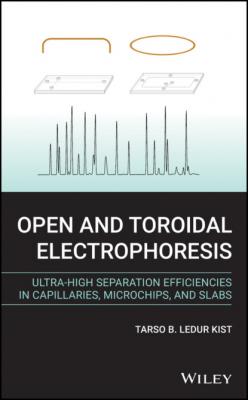ТОП просматриваемых книг сайта:
Open and Toroidal Electrophoresis. Tarso B. Ledur Kist
Читать онлайн.Название Open and Toroidal Electrophoresis
Год выпуска 0
isbn 9781119539247
Автор произведения Tarso B. Ledur Kist
Жанр Химия
Издательство John Wiley & Sons Limited
(1.6)
(1.7)
Here, both H2O and the H3O+ cation function as Brønsted acids. For a detailed discussion of dissociation and ionization in water see Soustelle (2016).[4]
Finally, it is important to remember that a small fraction of the self-ionization reactions of water produce H5O2+ and an even smaller fraction produce H7O3+, as well as other ions.
A great deal of knowledge is continuously generated about the internal structure and dynamics of liquid water. Topics such as self-ionization of water, the ions produced, the average life-time of these ions, solvation, and water clusters are difficult to treat because they can not be treated as events in a continuous, homogeneous fluid. They should be treated within the many-body problem theories; however, the number of entities in the case of water must be great to be realistic because the water molecules are very sticky with each other due to hydrogen bonding. So one can always remember a saying that remains true: “Of all known liquids, water is probably the most studied and the least understood”.[5]
1.1.7 Hydrophilicity, Hydrophobicity, and LogP
Hydrophilicity and hydrophobicity are qualitative terms that refer to chemical substances that, respectively, dissolve in water (strong affinity for water) or in non-polar substances (weak affinity for water). Solvation and the formation of hydrogen bonds are important processes involved in the dissolution of hydrophilic solutes in water (an environment rich in hydrogen bonds). On the other hand, no solvation or hydrogen bond formation occurs when attempting to dissolve hydrophobic (non-polar) substances in water. The dissolution of non-polar substances in non-polar solvents occurs because the positive entrophy change of the system (solvent
Microdrops of hydrophobic substances (e.g., vegetable oil) that are dispersed in water tend to irreversibly join (fuse) when random Brownian motion causes them to collide with each other. Each fusion event causes a sudden increase in the total number of hydrogen bonds in the given volume of water. Macrodrops are formed and at the end expelled from the bulk of the water, which again suddenly increases the total number of hydrogen bonds among water molecules. Note that the inverse reaction (converting a macrodrop of oil into microdroplets) is only possible with the input of a significant amount of energy (usually from vigorous mechanical stirring), as a large quantity of hydrogen bonds must be broken. Thus, it would be fairer to call water oleophobic instead of calling non-polar substances hydrophobic.
LogP (or CLOGP) is a well defined quantitative parameter that is related to the hydrophilicity and hydrophobicity of a chemical substance. It is a real number that goes from minus infinity to plus infinity (
Table 1.2 Examples of some LogP values. These are the average values of the
(Source: Data from DDBST GmbH, Oldenburg, Germany, www.ddbst.com.).
| Analyte | LogP |
|
| Acetaldehyde | 0.43 | 1 |
| Acrylamide |
|
3 |
| Aniline | 0.975 | 16 |
| Benzo[a]pyrene | 6.898 | 11 |
| Caffeine |
|
4 |
| Dimethylnitrosamine |
|
2 |
| L-nicotine | 1.39 | 1 |
The LogP of a chemical substance is defined as the decadic logarithm of its 1-octanol/water partition coefficient. The substance is dissolved in water or 1-octanol and then equal volumes of these solvents (one of which contains the substance under analysis) are placed in contact with each other and left to reach equilibrium. When equilibrium is reached the value of
(1.8)
Table 1.2 gives the LogP values of a few chemical substances. Such values are already used in structure–property correlations and quantitative studies of structure–activity relationships. As more LogP values become available, they will be used in pharmaceutical sciences, pharmanalysis, biochemistry, and analytical chemistry more frequently.
1.1.8 Gibbs Free Energy Change
The solubility (due to dissolution and/or dissociation and/or ionization) of a specific quantity of solute in a certain volume of a given solvent at temperature

